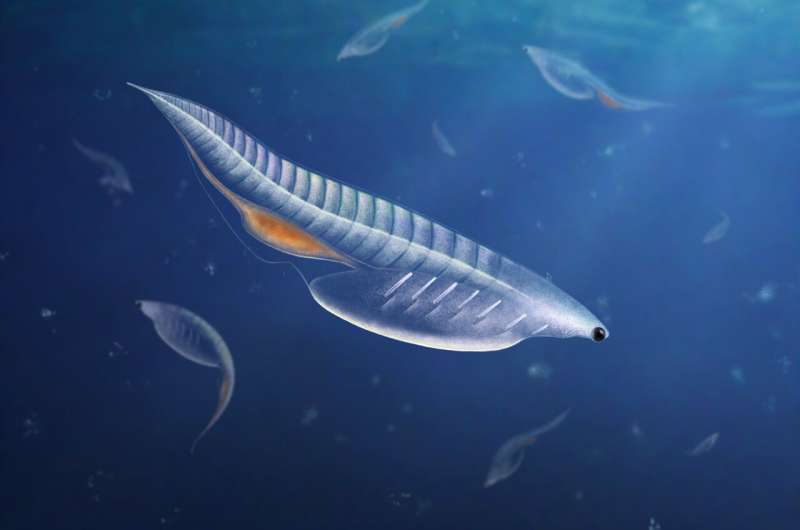
Nuucichthys rhynchocephalus gen. and sp. nov. from the Druian Marjum Formation of the House Range of Utah, USA. Credit: Royal Society Open Science (2024). DOI: 10.1098/rsos.240350
The Cambrian fossil record shows that many animal phyla were diverse and inhabited the Earth’s oceans about 518 million years ago. But while chordates—a group that includes vertebrates like humans—were part of the early animal diversity, they make up a small portion of the fossil record from places beyond 50 of the Cambrian worldwide.
In a new paper published by Royal Society Open ScienceHarvard research scientist Rudy Lerosey-Aubril and assistant professor Javier Ortega-Hernández present their surprising discovery of a new species of chordate, and the first soft-bodied vertebrate to discovered in the Drumian Marjum Formation of the American Great Basin.
The new fossils were part of a collection of Cambrian soft-bodied fossils housed at the Utah Museum of Natural History, a longtime collaborator with Harvard researchers.
The discovery of this new species, called Nuucichthys rhynchocephalus, is an important contribution to the early study of vertebrates and biodiversity due to the scarcity of these species in the Cambrian fossil record. —including South China, Northeast United States and British Columbia.
Nuucichthys is also one of only four species to record the earliest evolutionary stage of the vertebrate family, and is therefore one of its oldest relatives.
In their paper, Lerosey-Aubril and Ortega-Hernández describe Nuucichthys as having a wingless, torpedo-shaped body that includes numerous spine-like markings.

“The first vertebrates started to have big eyes and a series of muscle fibers that we call myotomes, and this is something that we recognize very well in our fossils,” Lerosey-Aubril said.
These new species also confirm that, despite their general resemblance to larval fish—having a cavity that is a form of organ system—they lacked fins and thus it had little swimming power.
“But all these characteristics clearly point to other vertebrate relationships,” Lerosey-Aubril said. “And because it’s early in the evolution of vertebrates, they don’t have bones yet—that’s why these fossils are so rare.”
Lerosey-Aubril and Ortega-Hernández hypothesize that Nuucichthys may have lived above sea level. Because of this, and because it lacked biomineralized components such as bone or shell, it was prone to rapid postmortem decay and decay, which explains why when they were rarely done.
“What’s interesting about this new species is that understanding how morphology evolved from invertebrate to vertebrate is difficult without fossils, and this new fossil tells us a little bit about that,” Ortega-Hernández said.
The site of Drumian Marjum where fossils were found has been intensively investigated since 2022 by an international team of paleontologists led by Lerosey-Aubril and Ortega-Hernández, and both agree that the effort continued collection in this area may result in the discovery of new specimens. of Nuucichthys rhynchocephalus in the future.
Additional information:
Rudy Lerosey-Aubril et al, A long-headed Cambrian soft-bodied creature from the American Great Basin, Royal Society Open Science (2024). DOI: 10.1098/rsos.240350
Presented by Harvard University
Excerpt: A simple needle in a haystack: Scientists discover a new species of chordate (2024, July 25) Retrieved July 25, 2024 from https://phys.org/news/2024- 07-soft-needle-oceanic-haystack-scientists html
This document is subject to copyright. Except for any legitimate activity for the purpose of private study or research, no part may be reproduced without written permission. Content is provided for informational purposes only.
#simple #needle #seaweed #Scientists #discover #species #chordate